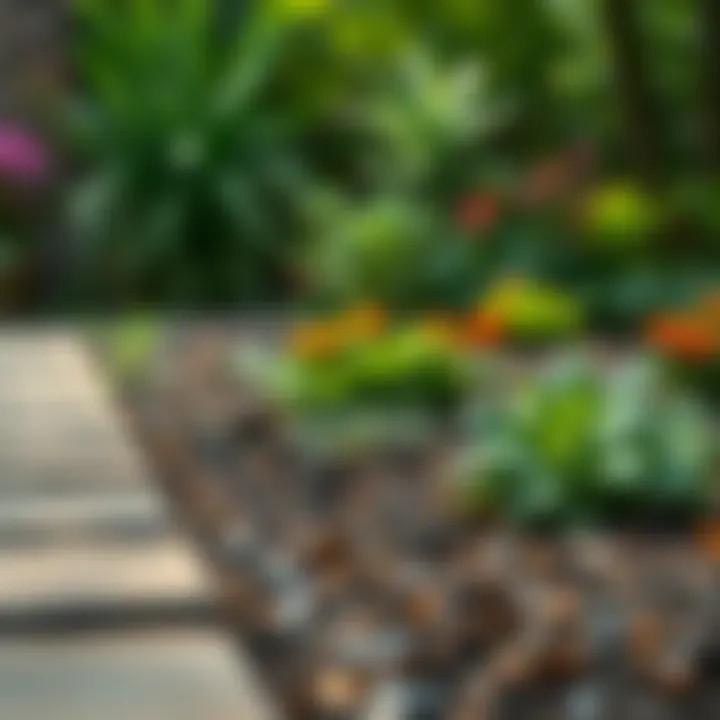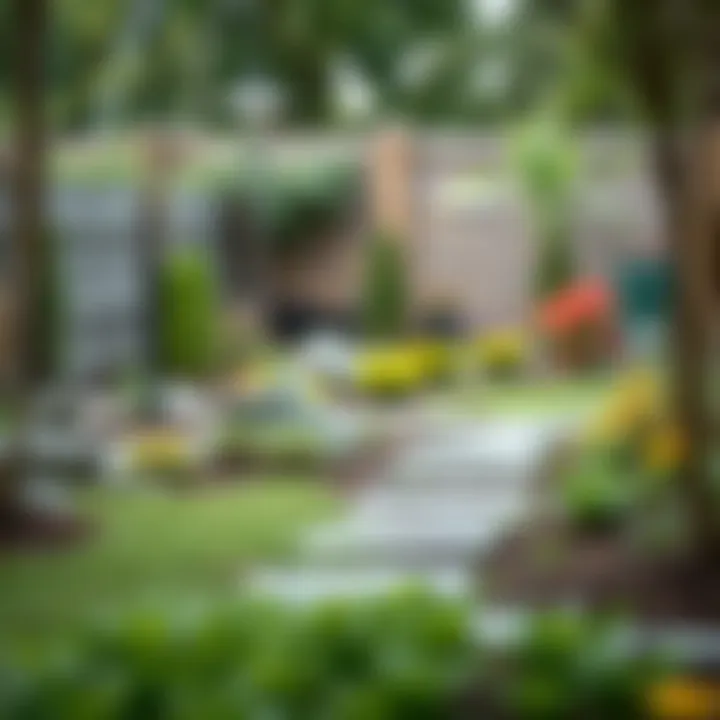Effective Ways to Fix a Wet Backyard


Intro
Dealing with a wet backyard can be a real thorn in the side for homeowners. Not only does excess moisture cause inconvenience, but it can also lead to unsightly puddles and health hazards such as mold growth. If your outdoor space resembles a swamp more than a garden, don’t toss in the towel just yet. This article digs into the nitty-gritty of why your yard is perpetually sodden and rolls out a selection of solid strategies aimed at transforming your damp space into a haven of greenery and comfort.
From understanding drainage dynamics to exploring landscaping tweaks, you’ll find a treasure trove of ideas that cater to varying tastes and budgets. Tackling these drainage issues doesn't just beautify your yard but also boosts property value by ensuring future buyers won’t be put off by soggy conditions. So roll up your sleeves and get ready to dig deep into the practicalities of addressing that unwanted wetness in your backyard!
Understanding the Problem of Excess Moisture
When it comes to enjoying a serene and inviting outdoor space, understanding the problem of excess moisture should rank high on any homeowner's priority list. A yard that’s perpetually soaked can lead to a slew of issues, ranging from unsightly puddles to a thriving ground for pests and mold. In this section, we aim to unravel the factors contributing to moisture accumulation in backyards, setting the stage for practical solutions that will eventually help in reclaiming your outdoor oasis.
Why is My Backyard Wet?
So, why is your backyard acting like a sponge? Usually, it boils down to a combination of environmental and structural factors. Homeowners often overlook various aspects while walking through their gardens in the sunny weather, taking for granted the role of drainage until they find their feet squishing in mud during or after a heavy rain. Recognizing the root causes can help lead to informed decisions about managing and rectifying the problem.
Common Causes of Water Accumulation
Notes on some common culprits behind a soggy backyard:
Poor Soil Drainage
Poor soil drainage is a significant player in the absentee performance of yard drainage capabilities. This aspect can greatly contribute to a yard that feels more like a marshland than a garden paradise. Heavy clay soils, for instance, struggle to allow water to seep through and instead retain moisture. This can create a situation where saturated soil leads to the downfall of plants, as roots drown in excess water. Well-draining soils, such as sandy or loamy, are often recommended to facilitate better moisture management, making poor drainage a key issue to address for any homeowner looking to improve the health of their backyard.
High Water Table
A high water table can be a persistent thorn in the side of any homeowner. This occurs when the groundwater level rises to the surface level during periods of rainfall or snowmelt. A backyard sitting above a high water table can easily turn into a swamp after a downpour. One distinctive feature of this condition is that it can vary seasonally. During dry months, the yard may appear normal, but this can shift dramatically during wet seasons. A lasting advantage of understanding this aspect means scheduling landscaping or drainage efforts effectively to coincide with lower water tables.
Construction and Grading Issues
Many backyards show signs of poor planning when constructed—namely, improper grading. The land must slope away from the home to prevent water from pooling near the foundation. If craftsmanship missed these details, the outcome is often a yard that retains water, turning it into an uninviting area. By identifying visible signs of these issues, such as sloped sections or areas where puddles form consistently, homeowners can devise a plan for remediation that may involve leveling certain sections of the yard or even installing more advanced drainage solutions.
Inadequate Vegetation
Sometimes, plant choices can degrade the yard's ability to deal with moisture. A landscape lacking dense and deep-rooted plants can fail to absorb enough water, allowing it to accumulate and affect the vitality of the remaining flora. Trees and shrubs, particularly native ones, tend to have a robust root system capable of soaking up a significant amount of water, while grasses may not suffice on their own. Choosing the right plants not only enhances aesthetics but also assists in mitigating moisture problems, creating a harmonious balance in nature's water cycle.
By understanding these common causes, homeowners are armed with a clearer perspective on their wet backyard situation. This foundational knowledge sets the stage for exploring comprehensive strategies aimed at tackling these persistent problems, paving the way for a more functional outdoor living space.
"An ounce of prevention is worth a pound of cure." This idiom rings true when we consider the importance of understanding moisture issues before jumping into solutions.
Assessing Your Backyard’s Drainage System
Evaluating the drainage system of your backyard is a cornerstone approach when dealing with excess moisture. Before jumping to any fix or solution, it’s essential to grasp how water moves through your property and what can be done to help it along. You can think of your yard as a living, breathing thing; when it becomes bogged down, it tells you it needs some help.
Evaluating Current Drainage Solutions
Start by taking a good, honest look at what you currently have in place for drainage. Take out your notepad and jot down anything that seems like it could be affecting the water flow. Do you have gutters? Are they directing water away from your foundation? If they’re not functioning, they might just be adding to your problems.
Take note of any existing drainage systems—like trenches or pipes. If they’re clogged with leaves, mud, or debris, they’re likely not doing their job. In some situations, rather than fixing those systems, you might need a fresh slate. If you find you’ve already got a top-notch drainage solution but it’s not working, consider its placement. Sometimes, it’s not about the solution but where it’s been situated. Doing this evaluation can save you an arm and a leg in costly mishaps down the line.
Identifying Problem Areas
It's like a treasure hunt but instead of gold, you’re looking for puddles, soggy spots, and hard clay. When you allow yourself to roam around, keep an eye out for any areas where the water seems to collect or where the soil feels consistently moist underfoot. You might notice:
- Pooling water after heavy rains: A definite red flag.
- Saturated soil: If you can’t stick a shovel in your yard easily, clay soil might be stifling proper drainage.
- Dead patches of grass or overly green areas may indicate excess moisture.
These indicators help you pinpoint where adjustments or improvements need to be made. Take measurements and mark out these problem locations on your sketch. It’s like playing detective, piecing together a system that, when understood better, can lead you to much-needed solutions.
Drainage Patterns in Your Yard


Observe the natural slopes and contours of your land. Visualize a map of your yard and how water flows across it. Water will always follow the path of least resistance, so identifying these patterns becomes crucial. Things to consider include:
- Which areas are most affected: Where water accumulates vs. where it drains well.
- Natural elevations and declines: This can tell you a lot about where drainage installations might be advantageous.
- The layout of your yard: Is it flat, or does it have slopes? Is there a zone where water might back up?
Drafting this map mentally or on paper will give clarity to which drainage solutions will fit best into your existing landscape. Taking notes while you assess these patterns will help create a clearer picture for your next step.
Understanding these elements deeply is not only essential for a remake of your yard but also plays a significant role in long-term planning and sustainability. By evaluating existing conditions, spotting trouble spots, and charting out drainage patterns, you’ll be on the right path to transforming your wet backyard into the serene outdoor living space you prefer.
"It's not just about fixing the problem at hand, but understanding it on a deeper level, so you can take smart steps forward."
For more extensive resources on backyard landscaping and drainage techniques, check out The University of Florida's Extension or the National Resource Conservation Service for helpful guidelines.
Landscaping Solutions to Improve Drainage
Tackling the issue of excess moisture in your backyard often starts with reevaluating your landscape. Landscaping solutions to improve drainage not only address the immediate problem of water pooling, but they can also transform your outdoor space into a more visually appealing and functional area. Through thoughtful design and certain techniques, you can direct water flow, enhance soil health, and cultivate a thriving garden rather than a marshy quagmire. The following subsections cover various landscaping approaches that can minimize moisture retention and promote proper drainage.
Creating Swales and Berms
Swales and berms are two effective and natural landscape features that can redirect water flow. Swales are shallow, broad channels designed to divert water away from saturated areas, while berms are raised mounds of soil that help direct runoff. When you construct a swale, you create a gentle slope that guides excess water towards a designated drainage point. This not only prevents pooling but also promotes soil absorption.
- Benefits of Swales and Berms: These features improve drainage and can increase the aesthetic appeal of your yard by adding elevation changes, which can be utilized for planting diverse vegetation. Additionally, they aid in preventing erosion and preserving soil health. When done right, these structures can play a crucial role in water management, helping mitigate flooding issues.
Implementing French Drains
French drains consist of a trench filled with gravel and a perforated pipe, and they are excellent for areas that seem to always collect water. The purpose of a French drain is simple: it collects excess water and channel it away from your yard, reducing sogginess. These systems can be particularly advantageous in poorly draining soils where water tends to accumulate.
- How They Work: Water seeps into the gravel, moves through the perforated pipe, and is directed away from unwanted areas. This system works wonders in basements or near foundations, shielding those areas from potential water damage.
Utilizing Rain Gardens
Rain gardens are specifically designed to hold water temporarily, allowing it to percolate into the ground rather than flow directly into storm drains. By creating a shallow depression filled with native plants, you can effectively manage runoff from your roof or driveway. They act like sponges, absorbing rainwater and providing a habitat for beneficial insects and birds.
- Advantages: Rain gardens reduce the amount of water entering local drainage systems, which helps in flood prevention. They also promote biodiversity and are an effective way to beautify your yard.
Choosing Appropriate Plant Species
Selecting the right plant species can significantly enhance drainage and contribute positively to the overall health of your landscape. It's essential to consider both drought-resistant plants and native species because they offer distinct advantages.
Drought-Resistant Plants
Drought-resistant plants are well-suited for areas that may experience both wet and dry spells. They are highly adaptable and require minimal water once established.
- Key Characteristic: Their ability to survive on limited moisture makes them a smart choice in wet backyards, as they can typically withstand waterlogged soil for a period.
These plants often feature deep root systems that help break up compacted soils, encouraging drainage. By incorporating them, you're not only improving the drainage capacity of your yard but also making a sustainable choice for your garden.
Native Species
Native plant species thrive in local conditions and require less maintenance than non-native varieties. They play a critical role in enhancing drainage by establishing robust root systems that enhance soil structure while minimizing erosion.
- Key Characteristic: These plants are adapted to your specific climate and soil type, making them a beneficial choice for those trying to manage excess moisture in their backyards.
When you choose native plants, you contribute to the local ecosystem, fostering habitats for wildlife while reducing the need for chemical fertilizers and excessive watering.
In summary, appropriate landscaping can greatly improve drainage and reshape your outdoor environment into a manageable and vibrant space. By implementing features like swales, French drains, rain gardens, and selecting the right plants, homeowners can mitigate the challenges of a wet backyard, ensuring a healthier, more beautiful landscape.
Hardscaping Strategies for Managing Water


When dealing with a backyard that seems like it could double as a small pond, hardscaping becomes a crucial part of the solution. Hardscaping refers to the non-plant elements of landscaping; it involves the construction of structures such as patios, walkways, and walls, which can strategically redirect water and minimize the formation of wet patches. These techniques not only address the drainage problem but also enhance the aesthetic appeal of your yard.
Selecting Permeable Paving Options
Permeable paving is one of the most effective hardscaping strategies for managing water. Unlike traditional concrete or asphalt, permeable materials allow water to seep through, reducing surface runoff and promoting natural groundwater recharge. Think of stones, porous concrete, or even bricks designed with spacing; they let nature do its job. Here’s why you should consider this route:
- Environmentally Friendly: By allowing rainwater to filter through, you lessen the risk of flooding in your yard and help recharge local aquifers.
- Reduced Erosion: With permeable surfaces, you minimize soil erosion that can occur with heavy rainfall.
- Versatile Uses: Whether it’s for a driveway, walkway, or patio, these options enhance functionality while keeping the surface dry.
However, it’s important to consider the maintenance aspect. Ensure the spaces between stones or bricks don’t get blocked with debris as this can limit water flow.
Installing Retaining Walls
Retaining walls play a significant role in managing water by holding back soil and redirecting water flow. When installed correctly, these walls can prevent excess water from spilling into parts of your yard where it’s not welcome. Think of it as a fortress against water intrusion. Here are the benefits:
- Soil Stabilization: They hold back moist soil, providing a level playing field that can help prevent erosion.
- Improved Drainage: A well-placed retaining wall can create a sloped area that guides water away from your home.
- Enhanced Aesthetics: Beyond functionality, these walls can act as a decorative feature, especially when using natural stones or appealing wood.
While installing retaining walls, make sure to account for proper drainage behind the wall itself. Integrating weep holes can further ensure that water doesn’t accumulate behind the structure leading to excessive pressure.
Constructing Decking Solutions
If you enjoy outdoor living, elevating your space with a deck can be a smart way to tackle wet backyard issues. Elevated decks provide an appealing solution that keeps your feet dry, even during those spring showers. Here’s what to keep in mind:
- Water Runoff Management: A deck can channel rainwater away from the foundation of your house and towards more absorbent areas of your yard. Positioning boards at a slight slope can further assist in directing water flow.
- Variety of Materials: From pressure-treated lumber to composite decking that mimics the look of wood, options abound. Choose a material that offers both durability and permeability if necessary.
- Integrated Drainage Systems: Including drainage systems alongside your deck can prevent water pooling beneath the structure, thereby maintaining a cleaner, healthier space beneath.
In summary, hardscaping strategies not only mitigate excess moisture but also provide practicality and beauty to your outdoor environment. Taking the time to consider how these elements can interact with your landscape will yield a durable solution that makes your backyard a more inviting place for both you and your guests.
Hardscaping serves as the backbone of effective moisture management, establishing both barrier and pathway for excess water, ensuring it flows away rather than settling in undesirable locations.
For more insights on managing water in hardscaping, consider visiting Wikipedia on Hardscaping or checking resources from The National Association of Home Builders.
You can also share your experiences or gather practical tips on platforms like Reddit where gardening enthusiasts often exchange information.
Managing Surface and Groundwater
Managing surface and groundwater is a fundamental aspect of creating a dry and flourishing backyard. It's important for homeowners to grasp the dynamics of water movement in their outdoor spaces, paving the way for effective strategies to circumvent the dampness plaguing their yards. When both types of water are effectively controlled, it significantly enhances not only the aesthetics of the landscape but also the longevity of the structures within it.
Key benefits of managing surface and groundwater include:
- Preventing soil erosion: Excess water can wash away soil, affecting the health of grass and plants.
- Enhancing plant growth: Proper drainage promotes a healthy ecosystem, allowing roots to breathe and absorb nutrients.
- Avoiding structural damage: Water pooling around foundations can lead to significant structural issues over time.
To effectively manage these waters, a combination of natural and engineered solutions can be explored, ensuring sustainability and effectiveness.
Utilizing Drainage Ditches
Drainage ditches serve as the unsung heroes of backyard moisture control. These channels direct excess surface water away from problematic areas, pouring it into designated areas where it can be absorbed or carried away. When planning your drainage ditch, consider the following:
- Location: Aim to position the ditch in areas where water tends to pool after heavy rains.
- Depth and slope: The ditch should be deep enough to accommodate runoff but also sloped to facilitate the natural flow of water.
- Vegetation: Plant natives along the ditch to encourage absorption and to stabilize the soil, preventing further erosion.
Effective use of drainage ditches not only improves drainage but also enriches the landscape, as they can be designed to look appealing, almost like decorative features.
Installing Sump Pumps
When groundwater levels rise, homeowners may face a tough situation. Here, sump pumps emerge as critical devices that help in managing water accumulation effectively. Essentially, sump pumps remove water that collects in a sump basin, usually located in the basement or lower levels of a home. Key considerations include:
- Type of Sump Pump: Choose between a submersible or pedestal pump based on your unique yard needs.
- Installation location: Situating the pump in the lowest part of your backyard can optimize performance.
- Power source: Consider a battery backup system to ensure functionality during power outages.
Utilizing a sump pump can be a game-changer, especially during heavy rainfall or rapid snowmelt, keeping your home safe and leak-free.


Using Dry Wells
Dry wells are a clever solution that homeowners can implement for managing excess groundwater. Essentially, a dry well collects and disperses water into the surrounding soil, effectively reducing surface water issues. Points to keep in mind when planning for dry wells include:
- Sizing the Well: The size should accommodate the volume of water likely to be collected; otherwise, it may overflow.
- Placement: Site the dry well away from your foundation, ensuring that it effectively receives runoff from gutters or other drainage systems.
- Maintenance: Regular checks to ensure the well is not clogged with debris is essential to its performance.
"When it comes to water management, a dry well can give your yard a breathing space, allowing it to manage moisture naturally and efficiently."
These strategies are not just about combating soggy grass; they’re about cultivating an environment where beauty meets functionality.
Maintenance Practices for Long-term Solutions
Maintaining a backyard that doesn't stay wet for long periods is crucial for enjoying your outdoor space. It’s easy to get caught up in the immediate solutions when dealing with moisture problems. However, without proper maintenance practices, those efforts may go to waste, and you could find yourself back at square one. Regular upkeep not only protects the investments made in landscaping and hardscaping but also ensures the long-term health of your yard.
A well-maintained drainage system minimizes water accumulation, thereby preventing issues like mold growth, soil degradation, and even plant health problems. Here are two focal points to keep in mind as you work towards maintaining a dry, inviting backyard.
Regular Drain Cleaning
A clean drainage system is like having a clear pathway for water to flow freely. Over time, debris such as leaves, branches, or sediment can accumulate in ditches, pipes, and drains. When this happens, you essentially create blockages that can lead to excessive water pooling in unwanted areas. Making a habit of cleaning your drains at least twice a year—or more frequently depending on your yard's specific conditions—is a wise move.
Some practical steps include:
- Remove debris: Clear out any visible dirt, leaves, or other obstructions you can spot. It’s easier to maintain a drain than to fix a problem created by neglect.
- Check for damages: Inspect everything. Look for cracks or signs of wear and tear in pipes or drainage areas. Immediate repairs can save larger expenses down the road.
- Utilize tools: Depending on the level of buildup, you might need tools. A snake can help remove deeper blockages, while a simple hose can flush away loose debris.
The benefits of regular drain cleaning are manifold. You’ll save money on repairs should blockages persist, and you’ll keep your yard cleaner and healthier. It also decreases the chances of flooding during heavy rains, letting water do what nature intended: flow away rather than pool in your backyard.
Seasonal Plant Care
Let’s face it: not all plants thrive in wet conditions. During each season, your plants require specific care to manage excess moisture and adapt to their environment effectively. Taking the time to assess the health of your plants can yield a blooming garden even when faced with challenging weather.
- Select plants wisely: Opt for drought-resistant or moisture-loving plants based on your yard's drainage situation. Native species thrive in local conditions and need less fuss.
- Know your seasons: Spring and fall require diversified care approaches. In spring, you might need to prune and fertilize to promote growth; as for fall, cut back on watering to avoid sogginess before winter.
- Monitor soil moisture: When you water, do so mindfully. Using a moisture meter can help ensure you aren’t overdoing it, encouraging deeper root systems.
"Healthy plants are like guardians of your landscape. They repel insects, provide shade, and offer a beautiful sight, all while keeping moisture in check."
This combination of wise plant selection and proactive care allows your garden to thrive and adapt, giving you a landscape that can better withstand wet spells. A well-kept yard not only enhances your property value, but it also creates a welcoming space for outdoor enjoyment.
When to Seek Professional Help
Addressing a wet backyard can sometimes feel like an uphill battle. While many homeowners take pride in figuring out how to tackle drainage issues on their own, there comes a time when the best call is to seek expertise from professionals. Knowing when to take a step back and consult experts can mean the difference between a manageable situation and a full-blown mess that damages your property.
Understanding when DIY is Insufficient
The urge to solve problems independently is a hallmark of homeownership. Yet, some situations demand more knowledge or advanced tools than most individuals possess. It's crucial to recognize when DIY efforts simply don’t cut it.
If you've tried a variety of DIY solutions, like digging trenches or planting specific vegetation, and still find your yard under water after heavy rainfalls, you might be fighting a losing battle.
Several indicators suggest you might need professional help:
- Persistent Standing Water: If water remains for days or increases after storms, a more robust solution is required, as soil saturation and drainage systems are clearly inadequate.
- Structural Damage: Noticing cracks in your foundation or other structural issues signals that the moisture problem extends beyond just an aesthetic frustration. Water damage can lead to serious problems if left unattended.
- Plant Health Issues: If your plants are thriving in dry spots but struggling elsewhere, it’s likely the moisture levels are unmanageable.
- Failing Equipment: If sump pumps or other installed draining methods are malfunctioning, it’s time to bring in the pros, who can assess and recommend heavy-duty solutions.
Being aware of these signs is vital, as neglect can lead to more severe complications down the line. By consulting with experts, you'll gain insights into more extensive drainage solutions tailored to your specific conditions.
Choosing the Right Experts
When it comes to hiring professionals, not all consultants are created equal. Understanding who to select can save not just, your budget but also headaches in the future.
Begin by evaluating potential contractors thoroughly. Check their credentials and reviews:
- Licensure: Ensure that the experts have the appropriate licenses to operate in your area. This often reflects a standard of professionalism and knowledge of local regulations.
- Referrals and Recommendations: Word-of-mouth can guide you toward reputable professionals. Ask friends, family, or neighbors who have dealt with similar problems.
- Experience: Focus on specialists with a track record in drainage solutions, and avoid those who dabble in too many fields. Specialists often have more refined techniques.
Don’t hesitate to gather multiple opinions before making a decision. Different experts may propose varying methods based on their experience, so it’s worthwhile to compare their approaches. Also, consider how they communicate:
- Clarity: Are they transparent about costs and methods? Avoid anyone shrouded in jargon or evasive about answers.
- Willingness to Educate: A good expert won't just fix your issue; they'll also help you understand the solutions and their long-term maintenance.
Ultimately, choosing the right professionals involves a blend of research, listening to recommendations, and noticing how they communicate with you. With proper guidance, your wet backyard can transform into a dry, inviting outdoor space.







